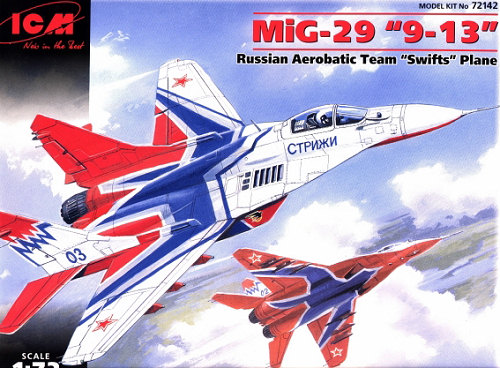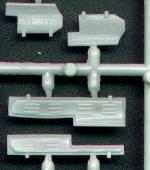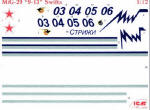
| KIT: | ICM 1/72 MiG-29 |
| KIT #: | 72142 |
| PRICE: | € 14.00 MSRP |
| DECALS: | One option: Swifts Aerobatic Team |
| REVIEWER: | Martin Pohl |
| NOTES: |

| HISTORY |
It was a deep shock for the CIA when they evaluated the data provided by their spy satellites of the Soviet test airfield Ramenskoje back in 1977. In the pictures showed outlines of a new airplane they haven't looked at before. The outline reminded them on the F-15, however with a smaller airframe – the Mig-29.
Back in 1972 the Soviet Union started the programs ‘advanced frontline hunting airplane’ (PFI) and ‘advanced light mass hunting airplane’ (PLMI), later ‘light frontline hunting airplane’ (LPFI). With the program PFI a hunter with the ability to escort bombers for wide distances should be created. With LPFI a hunting airplane to take the role in covering homeland and troops should be found which to be built in big numbers. The winner for PFI was the Suchoj Su-27. The Mig-29 was choosen to be the airplane for LPFI
The first prototype of the Mig-29 the 9.11 made its maiden flight on October 6. 1977. The serial production for the MiG-29 began in 1982 and the first machines entered service with the Soviet aerial armed forces in 1983. The MiG-29 can operate from prepared meadow. In 1984 the development of a version with higher weight was started the internal name was 9.14. The first big reworking was the development of the multi role combat aircraft MiG-29M but this was canceled soon. As an alternative the MiG-29S on the base of the older versions MiG-29 (9.12 and 9.13) was created. In parallel the development of the MiG-29K was started designed to be used on aircraft carriers. The MiG-29 was exported to Bulgaria, North Korea, Cuba, Germany, India, Iran, Iraq, Yemen, Yugoslavia, Malaysia, Poland, Romania, Syria, Czechoslovakia, Hungary and many others. Until today more than 1,500 of all versions of the MiG-29 were built.
| THE KIT |
 The
kit is boxed in four sprues, three light grey plastic ones and one clear sprue
for the two piece canopy and the lights. Only, I could not find where to put the
lights to, those are not mentioned in the instructions. The panel lines are
nicely engraved and very fine molded. The overall shape does look right to me
although I did not measure it. In a quick compassion to the Hasegawa Mig-29
these panel lines do look better than the ones of the Hasegawa Kit.
The
kit is boxed in four sprues, three light grey plastic ones and one clear sprue
for the two piece canopy and the lights. Only, I could not find where to put the
lights to, those are not mentioned in the instructions. The panel lines are
nicely engraved and very fine molded. The overall shape does look right to me
although I did not measure it. In a quick compassion to the Hasegawa Mig-29
these panel lines do look better than the ones of the Hasegawa Kit.
The cockpit is delivered as a tube with raised console detail and instrument panel. The control stick has also raised details. The provided seat looks really good for this scale, there are even some belts molded to it. The fuselage is split horizontally into two main parts. The intake doors are designed to be built closed. There is no inner detail to this section. The wings, fins and the tail unit are each molded in one piece. I found some flash on the inner side of one fin, but this could be removed easily.
 The
wheel wells and the gear doors have some raised details so they don’t look that
empty, the landing gear itself is fine molded with a lot of detail. The only
thing I’m wondering, whether this fine structures will be able to hold the
complete bird. Inside one of the engine paddle I found a little flash too, which
for sure is not that easy to remove. There is nothing telling about a nose
weight, so I would for sure put something in, just in case.
The
wheel wells and the gear doors have some raised details so they don’t look that
empty, the landing gear itself is fine molded with a lot of detail. The only
thing I’m wondering, whether this fine structures will be able to hold the
complete bird. Inside one of the engine paddle I found a little flash too, which
for sure is not that easy to remove. There is nothing telling about a nose
weight, so I would for sure put something in, just in case.
The provided external loads offer
different tanks and an assortment of three different rockets (short, middle and long range, I would suppose – I’m not an expert on Russian weapons) but
there are no instructions what to do with them. This is because the
demonstrators do seldom carry any weapons.
and long range, I would suppose – I’m not an expert on Russian weapons) but
there are no instructions what to do with them. This is because the
demonstrators do seldom carry any weapons.
The instructions are quite good although there is no text beside an extra little piece of paper telling in 20 languages that this kit is not suitable for little children and so on (well I should bring it back then I guess). The color codes are given in Model Master and AKAH numbers. The decals sheet offers only one option for the Russian acrobatic team Swifts and it only includes the surrounding lines. So a lot of masking has to be done (lot of fun to come J)
| CONCLUSIONS |
Compared to the Hasegawa kit it looks very well done, very fine detailing. If you like to go for a newer mold of a Mig-29, I recommend this, not only because it sells for almost half the prize of a Hasegawa (at least here in central Europe). Nothing against the Hasegawa Mig-29 kits, they are for sure older than this one. The only thing I can’t get, is, why they sell the Hasegawa on such a high price.
Thanks to me and my hobby store (Traudel’s Modellbau in Munich/Germany) for the review example.
| REFERENCES |
http://de.wikipedia.org/wiki/Mig-29
http://www.suchoj.com/index.htm
(all German, I’m sorry)
September 2007
If you would like your product reviewed fairly and quickly, please contact me or see other details in the Note to Contributors.